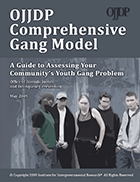OJJDP Comprehensive Gang Model Assessment Guide
The assessment guide A Guide to Assessing Your Community’s Youth Gang Problem provides a blueprint for conducting a comprehensive community gang problem assessment. It describes the areas of inquiry, data variables, and sources of the data, and it provides data collection instruments. It also provides suggestions on how to organize the data and guidelines for preparation of an assessment report to present the findings from the assessment.
Download PDF
View the Entire Document
- Assessment Guide
"A Guide to Assessing Your Community’s Youth Gang Problem"
Individual Chapters
- Introduction
This chapter describes the genesis of the OJJDP Comprehensive Gang Model and the Model’s five core strategies: (1) community mobilization, (2) opportunities provision, (3) social intervention, (4) suppression, and (5) organizational change and development. It also provides an overview of the assessment process.
- Getting Started
This chapter describes foundational activities prior to beginning data collection, including establishing common definitions of terms (gang, gang member, gang crime) and creating an administrative structure to conduct and oversee the work (Steering Committee, Project Director, Assessment Work Group, and Research Partner). Sample job descriptions, memoranda of understanding, and bylaws are also provided.
- Collecting the Data
This chapter provides an overview of the step-by-step process for collecting the data in five data domains. The next five chapters discuss each of these domains in greater detail.
- Community Demographic Data
Basic data about the community should be collected to provide context for other types of data, and to spot trends in population demographics as well as changes in the social and economic structure of the community. This chapter describes the information needed to provide a general description of the community, its population, and service needs.
- Law Enforcement Data
Because gang violence reduction is the focus of the OJJDP Comprehensive Gang Model, a key piece of the assessment is gang crime data. This chapter outlines the types of data to be collected from police incident reports, along with the methodology for collecting this data. This chapter also provides guidance on collecting, analyzing, and reporting aggregate gang intelligence data.
- Student and School Data
Data collected from students and school staff about gang activity at school is important to the assessment. A survey of students can identify risk and protective factors relevant to the community’s gang problem. A discussion of risk/protective factors and their impact on gang involvement by youth is included. This chapter also gives guidance about collecting data on student demographics, school disciplinary incidents, and school performance levels, as well as staff perceptions about gang activity on the school campus.
- Community Perceptions Data
Gang members themselves, community residents, parents, and community leaders may have very different perspectives on the impact of gangs on the community. This chapter discusses methods for collecting perceptions about gangs, including interview forms and protocols for use with gang members, surveys for use with community residents and leaders, survey/focus group questions for use with parents, and a survey for agency personnel.
- Community Resources Data
This chapter provides information on conducting a gap analysis in the community to identify existing resources to address gangs, and gaps in services. A data collection form is included for use in compiling information on current resources.
- Data-Collection Tools
A variety of different strategies can be used to collect information from community members, including focus groups, one-on-one interviews, and surveys. This chapter provides guidance on these methods, along with the advantages/disadvantages of each.
- Using the Data
Once the data have been collected, they should be collated, organized, and analyzed for parallels between the areas of inquiry. This section of the manual overviews the process of identifying key findings in the data and the process of writing the assessment report.
- References


